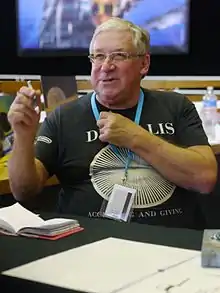Chris Foss
Christopher F. Foss (born 1946 in Guernsey, Channel Islands)[1] is a British artist and science fiction illustrator. He is best known for his science fiction book covers and the black and white illustrations for the original editions of The Joy of Sex.
- For the military author see: Christopher F. Foss
Career
Early work
Foss started working as an artist in his teens, in Guernsey, creating signage for local companies.[2] While studying at Magdalene College, Cambridge, he started pursuing professional magazine commissions, including the then recently launched Penthouse magazine.[2] He went to a boarding school in Dorset; his master encouraged him to train for an art scholarship.[3]
Science-fiction illustrations
Books featuring Foss illustrations include the 1970s British paperback covers for Isaac Asimov's Foundation Trilogy, several of Edmund Cooper novels, and E. E. "Doc" Smith's Lensman and Skylark series. Some of the art he did produce was specific to the stories and some examples of this are the covers he did for the Grafton publications of the Demon Princes novels by Jack Vance in the late 1980s, Star King, The Killing Machine, The Palace of Love, The Face and The Book of Dreams.
Not being a fan of science fiction, Foss typically did not read the books he illustrated, preferring to paint scenes entirely from his imagination.[4]
In 1975, Foss was hired by director Alejandro Jodorowsky for an intended film version of the science-fiction novel Dune by author Frank Herbert. He delivered several conceptual studies published in the book 21st Century Foss, ISBN 90-6332-571-1, containing a foreword by Jodorowsky. The project failed. In 1977 Foss worked for several months on studies for the movie Alien (not being used in the movie) and also did some designs of the planet Krypton for the movie Superman. Some of his crystal structures for the planet were realised in the movie, although they were used as ice-structures.
During this period Chris Foss illustrated the sleeve of the album Clear Air Turbulence for the Ian Gillan Band.
Painter Glenn Brown controversially appropriated individual space scene paintings by Foss[2][5] and in the one case copying and altering it (Exercise One (for Ian Curtis), 1995) and in the other, leaving it entirely unchanged (Dark Angel (for Ian Curtis), 2002). The titles of these works reference the vocalist of the band Joy Division, who died by his own hand.
Chris Foss created much of the color concept art for Sweetpea Entertainment's Traveller franchise, as produced by Imperium Games.[6]:332 He produced 12 pages of artwork for the new Traveller edition's first supplement, Starships (1996).[6]:332 He also illustrated a number of covers for Imperium's Traveller.[6]:333
Diary of a Spaceperson
In 1990, Foss released a book that was vague in many of the details of its production called Diary of a Spaceperson, published by Paper Tiger (ISBN 1-85028-049-5). It is a tome of his work to date. However, there is no way of knowing what that date is, which in some way provides some potency to the story within, as it is stated in the foreword that "the contents of the book are extracts of a 'spaceperson's diary' and are duplicated within", and "that the dates published within are of no meaning".
Although there is a vast number of his paintings within the book, hardly a large percentage of what he has produced is featured, and the fictional diary text itself also bears little connection to the paintings, except in some contrived ways. There is also no mention of the actual or original titles for any of the featured artworks, but many have been seen on the covers of authors' science fiction.
It also features many sketches in various states of completion, some of which are seen completed and painted in other parts of the book. In fact only some of the images, all of which feature architecture and craft, are rendered in paint; the rest of the works are nudes and sketches of women.
The Joy of Sex
In contrast, Foss's numerous illustrations for the sex manual The Joy of Sex are done in a much softer, natural style. The illustrations were based on photographs taken by Chris in his studio in Fulham, London.
Film work
- 1977 Jodorowsky version of Dune, spaceship and vehicle design.[7]
- 1978 Superman by Richard Donner. Planet Krypton and set design (not used)[7]
- 1979 Alien by Ridley Scott. Spaceship design (not used)[7]
- 1980 Flash Gordon by Mike Hodges. Redesign of Gordon's rocket cycle[8]
- 1995 Die Sturzflieger (German Sc-fi comedy) Spaceship design[8]
- 2000 A.I. Artificial Intelligence under Stanley Kubrick, until Kubrick's death in 1999[7]
- 2014 Guardians of the Galaxy under James Gunn, who brought him on board to design the film's various spacecraft.[9][10]
Bibliography
Notes
- Foss, Chris (2011). "Chris Foss: Biography". www.chrisfossart.com. Retrieved 9 September 2011.
- Parkin, Simon (20 February 2014). "The $5.7 Million Magazine Illustration". The New Yorker. Retrieved 21 February 2014.
- "Chris Foss Bio". chrisfossart.com. Retrieved 11 January 2017.
- Sumit Paul-Choudhury (7 September 2011). "Chris Foss: The Joy of Starships". New Scientist.
- https://www.newscientist.com/blogs/culturelab/2011/09/chris-foss-the-joy-of.html
- Shannon Appelcline (2011). Designers & Dragons. Mongoose Publishing. ISBN 978-1-907702-58-7.
- Video on YouTube
- Video on YouTube
- Woerner, Meredith. "Chris Foss Designed Spaceships For Guardians of the Galaxy!". Gizmodo. Retrieved 23 September 2017.
- Foss, Chris. "Chris Foss - Artist". ChrisFossArt.com. Digitalarte. Retrieved 23 September 2017.
External links
- Chris Foss's Official site and the only outlet on the web sanctioned by Foss
- Chris Foss at the Internet Speculative Fiction Database
- A gallery of Foss's French books covers
- About Chris Foss in French
- New Scientist interview with Chris Foss
- Chris Foss channel on YouTube

